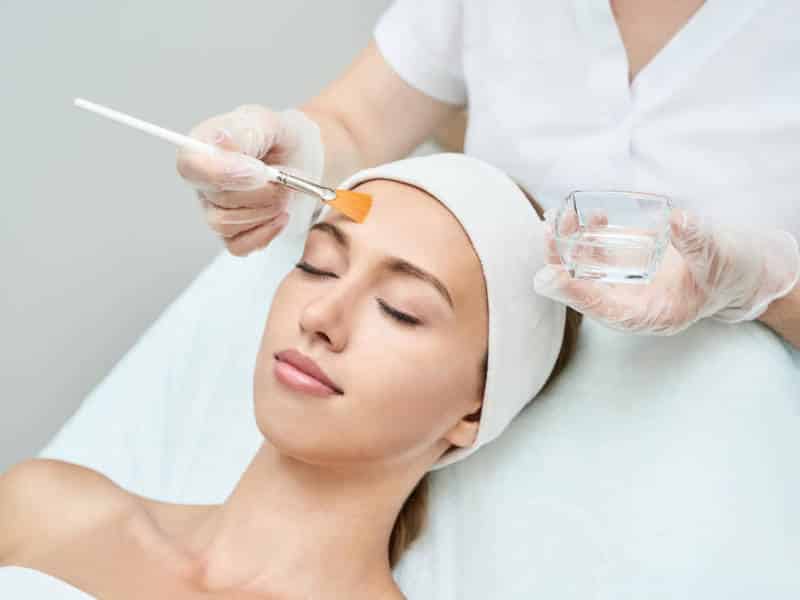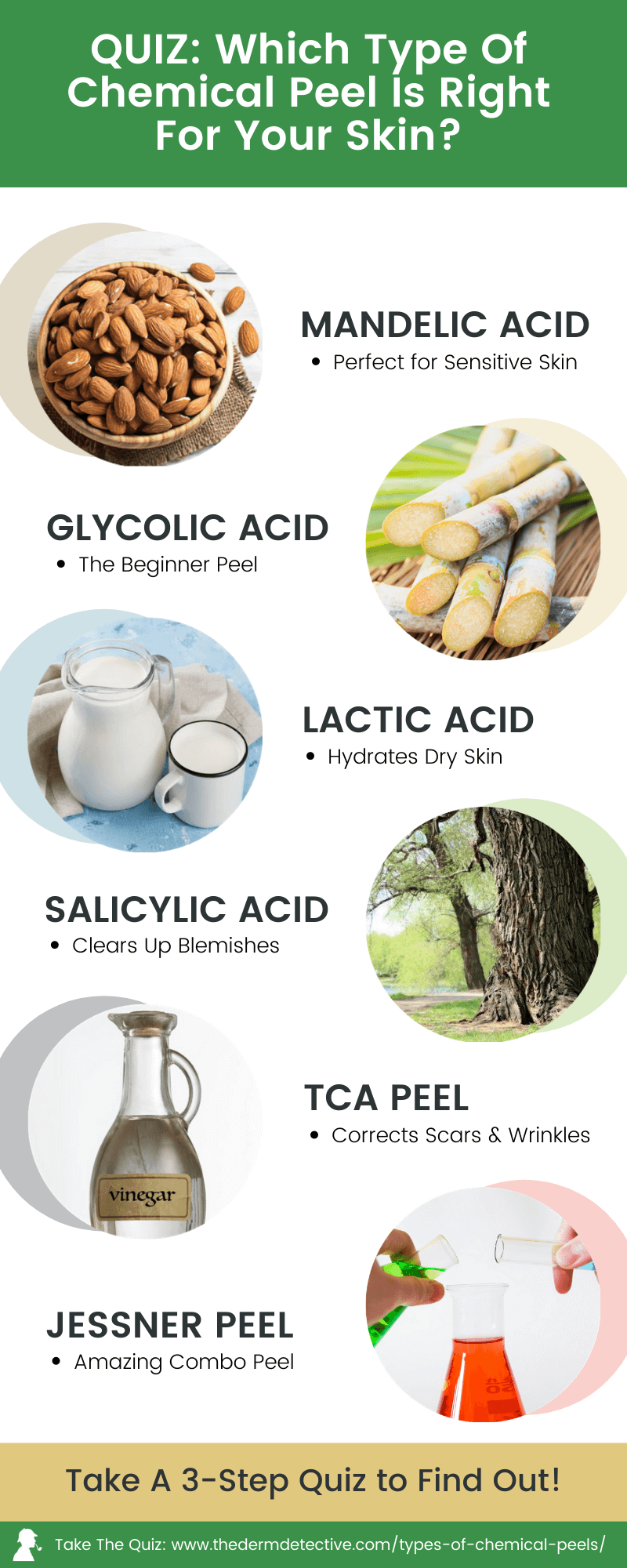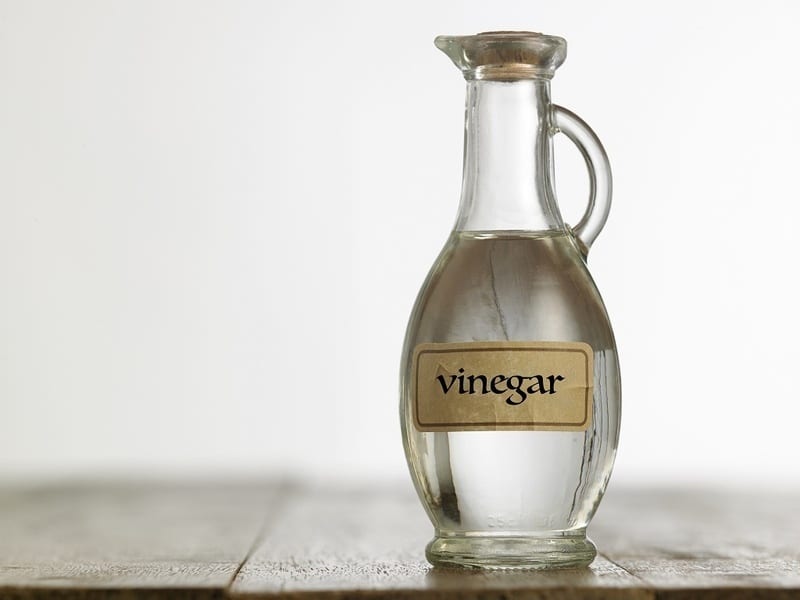
You know the benefits of a chemical peel already - now, the only question is, which one?
To help simplify your decision process, I've created a quick and easy quiz that will recommend the perfect chemical peel for you based on 3 key factors:
- Skin Type: some types of chemical peels are better suited for particular skin types. For example, salicylic acid peels are excellent for oily skin as it's a lipophilic molecule (it mixes well with oils) that can penetrate your skin's natural lipid barrier.
- Skin Concern: in addition, you want a chemical peel that will effectively address your primary skin conditions. Some are "jack-of-all-trades", like glycolic acid, that help with a little bit of everything, while others, like TCA, are more specialized.
- Experience Level: lastly, the quiz takes into account your level of experience. Generally, beginners should start with a light peel like mandelic, glycolic, or lactic, and gradually work up to deeper peels like salicylic, TCA, and Jessner.
Ready? Take The Quiz Now:
💡 Editor's Note: there are over a dozen different types of chemical peels right now, plus hundreds of brand name ones like SkinMedica's Vitalize Peel®, Obagi's Blue Peel®, and SkinTech's Easy TCA Peel®. However, to keep things simple, we've decided to focus on the most popular chemical peels (mandelic, glycolic, lactic, salicylic, TCA, and Jessner).
The 6 Types of Chemical Peels (Infographic)
Save or Pin this infographic! (to remind yourself which chemical peel to get next time)

1. Mandelic Acid

RELATED:
If it's your first chemical peel or you have sensitive skin, mandelic acid is the perfect option!
This alpha hydroxy acid (AHA) is extremely gentle and does not penetrate very deeply, thanks to its large molecular size (source: A Practical Approach to Chemical Peels, 2018).
In other words, you're much less likely to experience side effects like redness and irritation, and there's virtually no downtime required (no need to hide for a few days! 🤣).
A mandelic peel can help reduce the appearance of discoloration, like dark spots and uneven skin tone, as well as improve the symptoms of inflammatory acne and rosacea.
However, don't expect to achieve the same results as a deeper peel like glycolic acid - mandelic acid tends to produce more subtle effects due to its lower potency.
For beginners, I recommend starting out with 40% mandelic acid, especially if you've had a chemical peel before without complications.
But if you have very sensitive skin, start with 25% mandelic acid (just to be safe).
2. Glycolic Acid

RELATED:
Glycolic acid is the most popular type of chemical peel and remains a trusted staple for both beginners and advanced users.
It's the smallest alpha hydroxy acid (2 microns in length) and provides a balance between effective results and side effects / downtime (source: Nancy K. Brown).
With regular use, a glycolic peel will help soften rough skin texture and brighten skin tone by removing multiple layers of dead skin cells, damaged skin tissue, and excess oils.
This helps promote faster cell turnover to reveal brighter, smoother, and more even skin.
For beginners, I recommend starting out with 30% glycolic acid as it's a superficial peel that still delivers visible improvements after 4-6 treatments.
For advanced users, the next step up is 50-70% glycolic acid, which may provide better results for wrinkles, fine lines, crow's feet, and scars.
3. Lactic Acid

RELATED:
Cleopatra and the Egyptians have long known about the restoring effects of lactic acid - taking sour milk baths to smooth wrinkles and fix blemishes (basically: ancient Botox).
Nowadays, you can get the same "Egyptian glow", minus the odor of obviously spoilt milk, with a gentle and hydrating lactic acid peel.
A lactic peel is particularly good for hyperpigmentation, including dark spots, sun damage, and melasma, but works well for brightening your skin tone, too.
Like mandelic acid, lactic acid is very gentle and does not penetrate too deep into the skin (source: A Practical Approach to Chemical Peels, 2018).
Moreover, lactic acid is a humectant that can actually draw moisture into your epidermis to keep it hydrated (amazing for dry skin types!).
Generally, I recommend starting with 50% lactic acid, which is the most popular option, but if it's your first chemical peel, feel free to use a lower percentage like 20-40%.
4. Salicylic Acid

RELATED:
Let Me Guess:
You've tried everything in the "acne" aisle of your local drugstore / Wal-Mart and your dermatologist has already prescribed you countless oral antibiotics and topical creams.
Oh wait, that's actually my story!
But if any of this sounds familiar, I highly recommend adding a salicylic acid peel to your skin care routine to help clear up blemishes and prevent future breakouts.
Salicylic acid is a beta hydroxy acid (BHA) that is very unique - it has no problem penetrating through oily and acne-prone skin, thanks to its lipophilic properties.
This means it goes deep into your hair follicle (where the root cause of acne lies) to help remove the "sticky" piles of dead skin cells, keratin, and sebum, that are responsible for those pesky pimples like whiteheads and blackheads.
(in fact, most drugstore products use 2% salicylic acid to fight acne)
Overall, a salicylic peel will help you open clogged pores, prevent microcomedones from forming (the precursor to pimples), and keep your skin looking clearer and acne-free.
For most people, I recommend starting out with 20% salicylic acid, however, if you want a more gentle option, 10% is also available.
5. Trichloroacetic Acid (TCA)

RELATED:
One of the O.G. chemical peels, along with Jessner and Phenol, trichloroacetic acid (TCA) has been used for decades to treat wrinkles, fine lines, and acne scars.
That's because TCA is a medium peel that will penetrate beyond the epidermis and into the upper (papillary) dermis, where it's able to remove damaged skin structures to promote collagen production and healthy skin regeneration.
In other words, TCA is a powerful skin peel if your main skin concerns include anti-aging, scarring, and stubborn hyperpigmentation (age spots, sun damage, and melasma).
TCA is especially useful using the CROSS (chemical reconstruction of skin scars) technique where the acid is applied using a wooden toothpick into ice pick scars to break down the underlying scar tissue and encourage healthy skin to grow back.
A word of caution, though: TCA is considered an advanced peel, so make sure you're comfortable working with chemical peels first (including proper safety protocols).
In particular, pay attention to the number of layers as a TCA peel is cumulative (it will actually go deeper as you add more layers).
I recommend starting with 15% TCA, which is considered a light chemical peel that's similar to a 50-70% glycolic acid peel.
For TCA CROSS or body peels, go for 25-30% TCA instead.
6. Jessner's Peel

RELATED:
For over 100 years, estheticians and beauty experts have been using the Jessner Peel, a formula invented by German dermatologist Dr. Max Jessner in the early 1900s.
A.K.A. Jessner's Solution, the standard formula includes 14% salicylic acid, 14% lactic acid, and 14% resorcinol, and is generally considered a medium chemical peel.
You might also come across a modified Jessner's Peel that omits the resorcinol or replaces it with a substitute like glycolic acid.
Jessner's Peel is a powerful solution for advanced users as it combines the best parts of different chemical peels.
You get the blemish-clearing and oily-skin-penetrating salicylic acid, along with the toning, brightening, and hydrating lactic acid, and finally, the texture-smoothing resorcinol.
Overall, Jessner's Peel is an excellent treatment for many skin conditions, from breakouts to dark spots to wrinkles and fine lines.